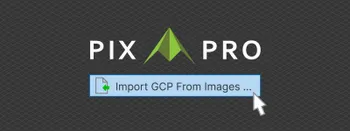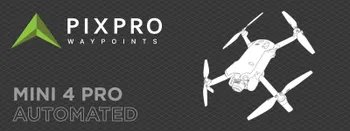From Pixpro to Sketchup
 Lukas Zmejevskis
Lukas Zmejevskis

SketchUp is a 3D design software that lets you create and edit 2D and 3D models with a simple interface. You can use SketchUp for various purposes, such as architecture, interior design, landscape architecture, asset design, and more. SketchUp also supports third-party plugins that add more functionality and features to the software. One such plugin made for photovoltaic engineering is Skelion. Skelion allows you to design solar thermal or solar power installations starting from a 3D model. The best way to acquire a 3D model of a building is photogrammetry. We will examine various photogrammetric 3D data export workflows from Pixpro and import SketchUp.
Data Capture and Processing
We described roof data capture and processing in Pixpro in multiple previous articles. A summary would be: capture an orbital or a more complex scan of your object. Then run the initial process of 3D reconstruction and dense point cloud in Pixpro. Crop your area of interest and then create the final, limited-size 3D model for export. To catch up on these processes in more detail, read:
Roof Scanning With Photogrammetry
Measuring Roofs with Photogrammetry
Easy Roof Inspection with Pixpro
Orbital Scanning with DJI
3D Model From Pixpro to Sketchup
Sketchup does not directly support full 3D model import, so the export process comes in three stages. The first stage is exporting from Pixpro, the second stage is model conversion in software called Transmutr, and the third stage is just opening a .skp file.
First stage - export from Pixpro. Once you have your final 3D model ready, exporting it is a matter of a few clicks. When exporting for Transmutr, we must ensure a single parameter - coordinate shift. To retain the scale of the model and make the file compatible for import into Transmutr and SketchUP, we need to use coordinate shift - 3D to center, to reduce the coordinate value lengths in the file. Otherwise, we can keep all other settings untouched.
Second stage - Transmutr software. We can convert the 3D mesh .obj file to a .skp file readable in Sketchup. You can drag the mesh file into Transmutr. Here, you may need to adjust a few settings. Mainly the unit conversion setting should be in meters. If your model is not oriented correctly, you may need to change the up-axis. Lastly, the origin point setting is often best set to the bottom center. With all settings set, and the 3D model looking correct in the preview section, you can click on transmute and select a directory for your .skp file.
Third stage - SketchUp. Now we can open the .skp file in SketchUp, and you should see the same thing as you saw in the Transmutr preview. Launch SketchUp and open the .skp file you created. To double-check the scale, you can measure any length in the 3D scene to see if everything is correct. If the scale is good, we can geolocate the model on the map. To do that, go to window>model info, and in the geolocation settings, you can add a location in two ways here.
3D Vectors From Pixpro to SketchUP
Suppose you do not need a 3D model for your work, just a vector framework of a building to start adding solar panels and evaluating scale. In that case, you can export lines in a 3D space. It is much easier and does not require an intermediary step with third-party software. The workflow is as follows:
- Draw your lines in Pixpro. We recommend using projections.
- Export your lines as .dxf CAD files.
- Open SketchUP and press import.
- Choose the AutoCad files (.dxf) option in the file format window.
- Go to the options menu and select Scale Units as Meters.
- Select your .dxf file and click on import.
The lines should appear in the main window of Sketchup, and now you can use these lines for further work. Again, we can add geolocation to the scene the same as before.
STL Export and Import
If you can get by without a texture on your 3D model, you can skip using Transmutr and directly import the .stl mesh into your project. The 3D mesh surface will be realistic and scaled. Still, you will not see the texture, hindering your ability to analyze the scene. The export from Pixpro and import process into SketchUP are identical to the .dxf file workflow; instead, we select the .stl files.
Point Cloud Export and Import
You can access point cloud import if you have the SketchUp Studio license with Scan essentials. Point cloud import may be an alternative way of using a photogrammetric base for drawing in SketchUp. This process is also straightforward: export the cloud from Pixpro and import it into a SketchUp project. The point cloud can be a reference for drawing lines or creating surfaces, but we did not test how well it works. However, drawing and exporting lines from Pixpro is probably the better choice.
Conclusion
We have many ways to import photogrammetry data into SketchUp. The best one will depend on your use case. It will take some experimenting to find the best solution for you. However, the effort is worth the result. You can make your workflow more efficient and precise by using export and import, not just redrawing with obtained measurements. You can make simulations much more accurate and visually representative with full 3D models. In combination with plugins like Skelion, this can be the way to work for many PV industry engineers and many others who already use SketchUp professionally.

Photographer - Drone Pilot - Photogrammetrist. Years of experience in gathering data for photogrammetry projects, client support and consultations, software testing, and working with development and marketing teams. Feel free to contact me via Pixpro Discord or email (l.zmejevskis@pix-pro.com) if you have any questions about our blog.
Related Blog Posts
Our Related Posts
All of our tools and technologies are designed, modified and updated keeping your needs in mind

Pixpro Waypoints v2 - Orbitals and Height Offset for DJI Drones
Pixpro Waypoints is a service for consumer DJI drone users that provides consistent and automated flying for aerial photogrammetry purposes. For now, we had the essential single grid flight only, which is the bread and butter for making orthophoto images and terrain scans.

RTK Drone Photos for Ground Control Points
Real-time Kinematic—RTK—is a GPS positioning system that allows for much greater accuracy than any regular GPS device. Consumer-grade GPS is quite sufficient for daily tasks such as navigation, tracking, and photo tagging, but when it comes to surveying, we need more accuracy.

DJI Mini 4 Pro Photogrammetry - Pixpro Waypoints
DJI Mini 4 Pro is the best drone, weighing in under 250 grams, and thus, it avoids a lot of regulations that may be bothersome for some. However, it is also an excellent tool for professionals, many of whom may be interested in aerial photogrammetry.
Ready to get started with your project?
You can choose from our three different plans or ask for a custom solution where you can process as many photos as you like!
Free 14-day trial. Cancel any time.
Welcome to Pixpro
Sign in
And access your account.
.svg@webp)